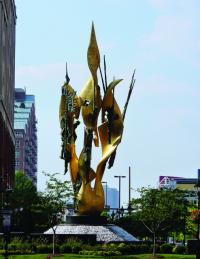
Katyn National Memorial in Baltimore.
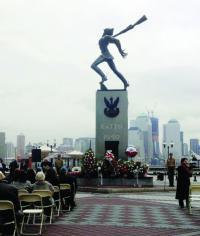
Katyn Memorial, Jersey City.

Katyn Memorial in Warsaw.
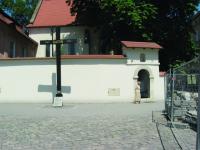
Katyn Memorial in Kracow, Poland.
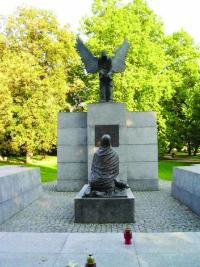
Monument to Katyn Massacre at Wroclaw, Poland.
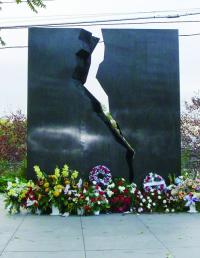
Katyn Memorial, Toronto, Canada.
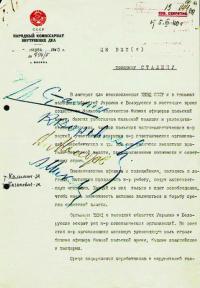
The Order

Katyn English language movie poster.

The victims
This month seventy years ago, Berlin Radio announced that German soldiers, serving under General Baron Rudolf Christov von Gersdorff, had discovered a mass grave of 4,243 Polish officers in the Katyn Forest, near the Russian city of Smolensk. In 1942, Polish railroad workers, working behind the German lines, converting the Soviet rails to conform to the German rails, had found the mass grave at Katyn and reported their findings to the Polish underground. No one would believe them because they could not believe that there were graves that contained as many dead as the railroad workers alleged. However, a discovery by German soldiers could not be ignored, nor would it.
Two days after the Red Army moved into Eastern Poland, in September 1939, Lavrentiy Pavlovich Beria, the People’s Commissar for Internal Affairs and First Rank Commissar of State Security, ordered the NKVD to create the Administration for Affairs of Prisoners of War and Internees. The Soviets did not consider the Polish soldiers, whom they captured, as Prisoners of War, but rather as counter-revolutionaries illegitimately resisting the authority of the newly expanded Ukranian and Belorussian Soviet Socialist Republics, which occupied the eastern part of Poland in late September 1939. The Soviets shipped 230,000 Polish soldiers, who were taken into custody, east to a number of camps. Many of the soldiers were reservists who had been called up to defend their country, when it had been attacked by Germany.
Beria sent a note to the Soviet Politburo, recommending the “elimination” of some twenty-five thousand Polish “Nationalists and Counter-Revolutionaries.” Upon the approval of the Politburo, the process was set in motion, which would result in the murder of those 25,000 people, that would come to be known as the “Katyn Massacre.”
One of the camps was located at the Village of Cozelsk, which is near the City of Kaluga in Russia. This camp was used mainly for officers of the Polish Army and housed about five thousand. The victims were murdered in either the camps and then transported to Katyn Forest, or they were transported to the Katyn Forest, where they then were murdered. In any event, most were buried there, although some were buried in other places. The term “Katyn Massacre” has come to represent all Polish soldiers and the intelligentsia that were murdered while in Soviet custody.
Among the dead at Katyn are an Admiral, two Generals, 24 Colonels, 79 Lieutenant Colonels, 258 Majors, 654 Captains, 17 Naval Captains, 3,420 NCOs, seven Chaplains, a Prince, 20 university professors, 300 physicians, several hundred lawyers, engineers and teachers, and more than 100 writers and journalists, as well as about 200 pilots. It was an attempt, by the Soviets, to sever the head from any potential resistance to the new order.
In the month of April 1940, Soviet NKVD Major-General Vasili Mikhailovich Blokhin personally executed between six and 7000 Polish prisoners in 28 days. For his, “...skill and organization in the effective carrying out of ‘special tasks’...” he was presented with the Order of the Red Banner and a small pay increase.
After the Axis Nations launched Operation Barbarossa, in June 1941, and invaded the Soviet Union, the U.S.S.R. executed a treaty with the Polish government-in-exile, in London, that declared all previous agreements with the German Reich null and void, and agreed to allow one of the few surviving Polish Generals in its custody, Lieutenant-General Wladyslaw Anders to form a Polish Army to fight alongside the Red Army. Eventually, friction with the Soviets caused Anders to take his men out of the Soviet Union. As the II Polish Corps, they would capture Monte Casino in Italy.
One of the sources of the friction between General Anders and the Soviet government was the continual questioning, by the General, about Polish officers who had been taken into custody by the Soviets, that he wanted to use in the formation of his army. These questions were embarrassing to the Soviet authorities. Stalin assured him that they were all freed, but they could not all be accounted for because the Soviets had “lost track” of them in Manchuria!
The Reichsminister of Propaganda, Dr. Josef Goebbels, recognized an opportunity when he saw one. On April 13 Radio Berlin broadcast to the world that German soldiers had uncovered, “...a ditch...[92 feet by 52 feet] in which the bodies of three thousand Polish Officers were piled in twelve layers.”
The next day Dr. Goebbels wrote in his diary that,
“We are now using the discovery of twelve thousand Polish Officers murdered by the NKVD for anti-Bolshevik propaganda on a grand style. We sent neutral journalists and Polish intellectuals to the spot where they were found. Reports now reaching us from the head are gruesome. The Führer has also given permission for us to hand out a drastic news item to the German press. I gave instructions to make the widest possible use of the propaganda material. We should be able to live on it for a couple weeks.”
On April 15 the Soviets responded that, “...Polish prisoners of war, who in 1941 were engaged in country construction work west of Smilenski had fallen into the hands of the German Fascist Hangman....”
The Germans then assembled 18 of the foremost forensic experts and their staffs from Belgium, Bulgaria, Denmark, Finland, France, Italy, Croatia, The Netherlands, Romania, Sweden, Slovakia and Hungary. The Germans also brought British, Canadian and American POW officers to the sites. Included among the group were the Polish writers Józef Mackiewicz and Ferdynand Goetel, both of whom had to leave Poland because of their involvement. The experts unanimously concluded that the executions had occurred in early 1940, at a time when the area was still under Soviet control, and before Operation Barbarossa.
In April 1943, when the Polish government-in-exile, insisted on an investigation by the International Red Cross, Stalin accused them of collaborating with the Germans, broke diplomatic relations and established a Polish, Pro-U.S.S.R., communist, government-in-exile in Moscow. Of course, this had merely been a convenient excuse, for Stalin had no intention of allowing the people in London to establish a government in postwar Poland. And his purpose in murdering all of those people, at Katyn, was to eliminate the people who would be most likely to oppose “The Dictatorship of the Proletariat.”
After being informed that the Wehrmacht was going to have to withdraw from the Katyn area, Dr. Goebbels, on September 29, 1943, wrote in his diary,
“Unfortunately we have had to give up Katyn. The Bolsheviks undoubtedly will soon ‘find’ that we shot twelve thousand Polish Officers. That episode is one that is going to cause us quite a little trouble in the future. The Soviets are undoubtedly going to make it their business to discover as many mass graves as possible and then blame it on us.”
When the Red Army re-occupied the area, a cemetery, which the Germans had permitted the Polish Red Cross to build, was destroyed. In January, the Soviet Union established the “Special Commission for the Termination and Investigation of the Shooting of Polish Prisoners of War by German Fascist Invaders in Katyn Forest.” It was commonly referred to as the “Burdenko Commission” because it was chaired by Nicolai Burdenko, President of the Academy of Medical Sciences of the USSR. The report it issued declared that - SURPRISE! - as Dr. Goebbels had predicted, all shootings were done by German occupation forces in the Autumn of 1941.
In 1944, President Franklin D. Roosevelt directed the Special Emissary to the Balkans, former Pennsylvania Governor, Navy Lieutenant-Commander, George Howard Earl III, to investigate the Katyn Massacre. Having done so, Governor Earl concluded that the Soviet Union was, indeed, responsible. The President rejected the Governor’s conclusion, announcing that he was convinced of German culpability. When Governor Earl requested permission to publish his finding, the President issued a written Order to desist and reassigned him to American Samoa - in the middle of the Pacific Ocean - for the balance of the war. He got off lucky! When the pretender to the Polish throne, London resident Count Geoffrey Wladyslas Vaile Potocki de Montauk, published his “Katyn Manifesto,” the British arrested and imprisoned him! The Western Allies were not going to allow their Soviet Ally, who was winning the war for them, to be embarrassed by the discovery of the bodies of a few thousand Poles!
In 2007, Michal Kwiecinski produced a movie, titled “Katyn,” about the massacre, based on the book by Andrzej Mularczyk, which was nominated for an Oscar in the “Best Foreign Language Film” category.
On February 4, 2010, Vladimir Putin, then Prime Minister of the Russian Federation, invited Polish officials to visit Katyn, in April, to commemorate the massacre. “Katyn” was shown on Russian state television for the first time. Polish Prime Minister Donald Tusk attended a ceremony with Putin on April 7, 2010. Three days later, a plane carrying Polish President Lech Kaczynski, his wife and 87 other high ranking government officials and military officers to Katyn, crashed near Smolensk, killing all aboard. One writer observed that that soil liked Polish blood.
The National Katyn Massacre Memorial is located at the southern end of President Street, at its intersection with Aliceanna Street, in Baltimore, Maryland. Lt. Janina Dowbar-Musnicki Lewandowska, a pilot in the Polish Air Force, daughter of a Polish general, and the only woman murdered, is depicted on the Memorial with two other officers. The Memorial bears the inscription, “If I were ever to forget them, may God forget me.”
NEXT WEEK: THE FALL OF TUNISIA
Mr. Wimbrow writes from Ocean City, Maryland, where he practices law representing those persons accused of criminal and traffic offenses, and those persons who have suffered a personal injury through no fault of their own.
«Go back to the previous page.








